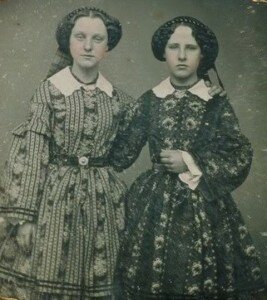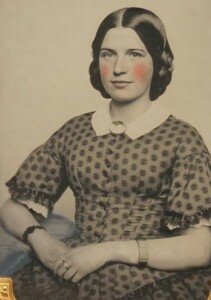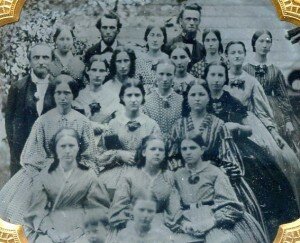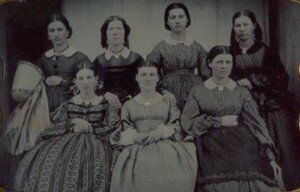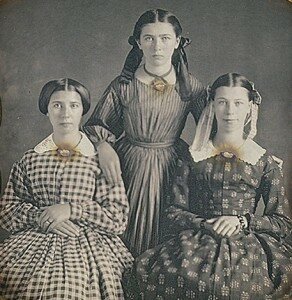How to Dress as a Pioneer Girl
For a printable PDF of this article, click How to Dress as a Pioneer Girl .
If you are younger than 18, and unmarried, you are a girl in the mid-19th century.
Congratulations! The styles of clothing appropriate for your social group are comfortable, and have some options not open to adult women. There are distinct advantages to dressing your age. Undergarments
The majority of a girl’s wardrobe is actually undergarments: she’ll usually have two or three changes of stockings, chemise & drawers, and one set of petticoats, even if she owns only one dress. Pioneer girls wore undergarments very similar to adult women:
- A chemise or shift, white cotton or linen, like a short-sleeved slip. Hemmed about the knee.
- Supportive stays are the “sports bra” of the mid-century. These use soft cotton cording for support, rather than steel or whalebones. For one-time pioneer experiences, you won’t need this garment. If you’ll be doing similar things on a regular basis, you might consider adding stays.
- Petticoats are used for skirt support, and to create the common silhouette of the era: low shoulders, tidy waist, and a belled expanse of skirts. Plain white cotton fabric, pleated or gathered to a waistband, works well for petticoats. Plan to wear at least one—many girls from the pioneer era wore between three and five petticoats, plus their dress! These petticoats are moderately full, between 90” and 160” around.
- Drawers in white cotton, with a cut-to-measure waistband, and hemmed between lower knee and mid-calf. Not all adult women wore drawers mid-century, but they are more common for girls. Drawers often have an open center seam, making it easier to use an outhouse or chamber pot without removing clothing. If you will be walking, drawers can help prevent your thighs chafing. (PJ or lounge pants are not the same thing, and won’t protect you the same way!)
- White cotton, or natural, white, or black wool stockings are common. For a one-time trek, plan to take several pair of white cotton knee-high socks. A bit of lycra content is normal these days, and won’t affect the performance.
Shoes
Black or brown leather boots, about ankle high, with a flat sole and small, “stacked” (fat) heel, will approximate mid-century styles. While some did make the trek west with bare feet, it’s safest to wear shoes today (as they did, if they had them). You’ll stay the most comfortable in leather. Be sure your shoes are well-broken in before your trek!
Dress Lengths
Young girls (12-14) should hem their dresses and petticoats to about mid-calf. Older girls (14-18) should hem their dresses and petticoats to between the lower calf, and about a hand-span above the ankle bones. You’ll be cooler, and move a bit more easily, than adult women. Skirts and petticoats are moderately full, from 90” to 160” around.
Dress Styles
Many girls, regardless of their financial circumstances, would expect to own two or three dresses. With baggage limitations on the trail west, two or three dresses is about the maximum for anyone; for handcart emigrants, two dresses (one to wear, one saved back) seems to be fairly common.
Young women may wear nearly any bodice style! Your bodices will generally close in the back with buttons or hooks, though older girls (16-18) may be switching to front-fastening bodices worn with youthful, shorter skirts. A one-piece dress (skirt attached directly to a bodice with sleeves) allows for simple dressing and easy movement when worn, and is the most common option for girls in the pioneer era.
Your bodice might be darted-to-fit, or gathered-to-fit at the waistline, with smoothly fitting sides. You may wear either a jewel neckline, or a more open neckline. You can also choose among a wide variety of sleeves: short puffed, short straight, short loose; long straight, long shaped, or long full sleeves gathered to a band at the wrist. Printed fabrics, checks, and plaids are all good choices for your dress. If you’ll be using your pioneer clothing for on-going living history, take the time to research appropriate printing styles and colors before making your dress.
Accessories & Hair
Neckerchiefs keep the neckline of your dress cleaner, and absorb sweat and body oils easily. They’re easy to clean without a lot of water, too—far easier to launder than your whole dress! Aprons (bibbed or plain) keep the front of your dress cleaner, too. A shawl is also very common as a girl’s warm wrap.
For the trek, a sunbonnet is the most common headwear. Before your journey westward, and after your arrival in Zion, you might well wear a pretty fashion bonnet, though many girls stuck with the sun protection of a sunbonnet with cording or slats to stiffen the brim.
Girls also have more hairstyle options than women. A center part (without bangs) is very common. Short, “cropped” hair (chin to shoulder length bobs), or long hair worn in three-strand braids starting just behind each ear are both typical girls’ styles that you can easily recreate today. Longer braids can be pinned up at the back of the head to keep them out of the way. You’ll want to wear your hair in a contained style (braids, or held back with a ribbon if you have short hair), to keep it as clean as possible, and keep the dust and other trail “nasties” out of it.
